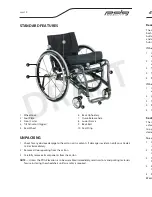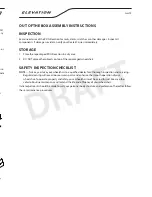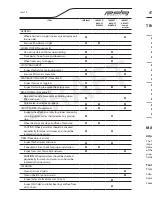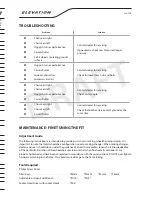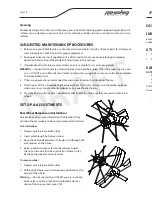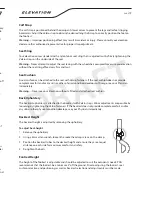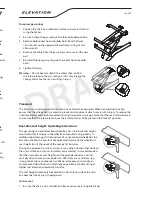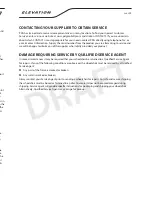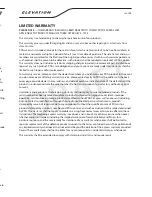
DRAFT DRAFT
page
26
page
3
SPECIAL NOTES
WARNING/CAUTION
— notices as used in this manual apply to hazards or unsafe practices which could
result in personal injury or property damage.
NOTE
— THE INFORMATION CONTAINED IN THIS DOCUMENT IS SUBJECT TO CHANGE WITHOUT NOTICE.
WHEELCHAIR USER
— As a manufacturer of wheelchairs, PDG endeavors to supply wheelchairs to meet
many needs of the end user. However, final selection of the type of wheelchair to be used by an
individual rests solely with the user and his/her health care professional capable of making such a
selection.
WHEELCHAIR TIE-DOWN RESTRAINTS AND SEAT RESTRAINTS
— PDG recommends that wheelchair
users NOT be transported in vehicles of any kind while in wheelchairs. As of this date, Transport
Canada, and the Department of Transportation has not approved any tie-down systems for
transportation of a user in a moving vehicle of any type while in a wheelchair.
It is PDG’s position that users of wheelchairs should be transferred into appropriate seating in vehicles
for transportation and that use be made of the restraints made available by the auto industry. PDG
can not and does not recommend any specific wheelchair transportation systems.
REGARDING RESTRAINTS - SEAT BELTS - IT IS THE OBLIGATION OF THE HME DEALER, THERAPISTS
AND OTHER HEALTH CARE PROFESSIONALS TO DETERMINE IF A SEATING RESTRAINT IS REQUIRED TO
ENSURE THE SAFE OPERATION OF THIS EQUIPMENT BY THE USER. SERIOUS INJURY CAN OCCUR IN THE
EVENT OF A FALL FROM A WHEELCHAIR.
SAFETY SUMMARY
Operating Information Warning
To determine and establish particular safety limits, practice bending, reaching and transferring activities
in several combinations in the presence of a qualified health professional BEFORE attempting active use
of the wheelchair.
6
DO NOT
attempt to reach objects if you have to move forward in the seat.
6
DO NOT
attempt to reach objects if you have to pick them up from the floor by reaching down
between your knees.
6
DO NOT
lean over the top of the back upholstery to reach objects from behind as this may cause the
wheel chair to tip over.
6
DO NOT
shift your weight or sitting position toward the direction you are reaching as the wheelchair
may tip over.
6
DO NOT
use an escalator to move a wheelchair between floors. Serious bodily injury may occur.
6
DO NOT
attempt to stop a moving wheelchair with the wheel locks. WHEEL LOCKS ARE NOT BRAKES.
4
Before attempting to transfer in or out of the wheelchair, every precaution should be taken to reduce
the gap distance. Turn both casters toward the object you are transferring onto. When transferring to
and from the wheelchair, ALWAYS ENGAGE BOTH WHEEL LOCKS.
6
DO NOT
operate on roads, streets or highways.
6
DO NOT
climb, go up or down ramps or traverse slopes greater than 9º.
6
DO NOT
attempt to move up or down an incline that is wet, icy or contains an oily film.

